Over the last decade, efforts to use compensatory mitigation to manage and ameliorate the impacts of development on biodiversity and ecosystems around the world have accelerated. Mitigation mechanisms provide a structured way to advance economic development and infrastructure while also achieving environmental goals. In order to operationalize mitigation programs, practitioners need a methodology for calculating or quantifying impacts and offsets (debits and credits). The methods currently employed in the U.S. and abroad are extremely varied. Surprisingly, the literature on best practices or standards for developing science-based approaches to the quantification of impacts and offsets is sparse and there is also no single broadly accepted best practice guidance.
This paper analyzes a sample of quantification methods currently in use to identify the most commonly used metrics and methods for quantifying impacts and offsets and evaluate the degree to which these methods conform to existing guidance. We reviewed 43 mitigation quantification protocols to assess both “what” these methodologies were measuring (i.e., the metrics used to quantify impacts and offsets) and “how” they were measuring it (i.e., direct or in direct measures of ecosystem functions).
Interestingly, we found no trends in “what” or “how” biodiversity and ecosystems have been measured over time and thus see no indication that these methodologies have been converging over the study period (1965 to 2014) on a common set of metrics and methods for quantifying impacts and offsets. This is an indication that information on best practices is poorly shared across different types of mitigation programs (e.g., species program to wetland program) and even within the same program types (e.g., wetland program to wetland program). When current measurement practices (both “what” and “how”) are compared to the limited best practices outlined in professional and academic literature, we also find that few of the protocols adhere to these existing recommendations. This is another indication that existing technical guidance on quantification methodology development is poorly shared or somehow falls short. We conclude that there would be great benefit to investing in the development of further science-based literature on and best practices for the development of robust, reasonably precise mitigation quantification methodologies. We also offer several recommendations for further academic research on the topic that we believe would help to improve the ability of mitigation programs to achieve conservation objectives. Ultimately, we hope that this analysis can inform the development and dissemination of robust best practice guidance and the adoption of quantification tools that reflect high standards for conservation.
Nicholas Institute for Environmental Policy Solutions
Publisher
Copyright
| Permalink: https://hdl.handle.net/10161/26717


